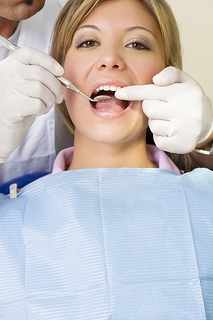I haven’t been to the dentist in years; what should I expect?
February 16th, 2023

Time flies when we are not at the dentist! Before you know it, years may have gone by. Let’s take a moment to explain what takes place when a patient comes back to receive care after an extended period of time.
After a while, small dental concerns or issues can grow into an unexpected journey of discovery and expense. Anxiety is common and expected. Let’s discover first of all, “What brings you here today?” It is a good place to start and once the initial concerns are addressed, a comprehensive plan to restore optimum dental health can be arranged. During the first appointment Drs. Peter Vogel, Vijal Vadecha and our team want you to feel comfortable, and establish a confidence allowing you to be open with any questions.
Your visit will take approximately 90 minutes. First, a complete medical and dental history will be recorded and reviewed in one-on-one interview style. This is the time to voice any concern, anxiety issues, worries, etc. Then, X-rays are taken to provide additional information about what is happening beneath the surface of your teeth and gums. Finally, a series of screenings including those for oral cancer, home care evaluation, and periodontal disease are conducted to complete your oral health evaluation.
The hygienist has a great eye for other conditions such as broken fillings, cracked teeth, active decay, and other dental concerns. Then, Drs. Peter Vogel, Vijal Vadecha will come in for a comprehensive exam and list and prioritize your dental needs. Our treatment coordinator will present scheduling options, insurance coverage, and payment plans.
Our team will coach you and help you gain control of your own dental destiny with good home care habits. You will receive a bag with a toothbrush, floss, appropriate toothpaste, and any other specialized tools for your needs. You will know how often you need to return for hygiene visits or other dental appointments.
Our patients at Daisy Mountain Dentistry are our most important asset, and we strive to create a comfortable experience, no matter how long it has been since your last visit at our Anthem office. From phone conversations to financial arrangements to clinical treatment, we want you to feel confident that our team will meet your needs.
Choose Chocolate on Valentine's Day
February 9th, 2023

From a student handing out sweets for her classmates to an older married couple exchanging boxes of candy, Valentine’s Day is the time of year when people like to show affection by gifting sugary treats to their loved ones. Whether you’re on the giving or receiving end of Valentine’s Day candy, you can celebrate the holiday in a healthier way by making dark chocolate your confection of choice.
Contribute to Your Health
According to the Cleveland Clinic, studies have shown that the cocoa beans used to make chocolate contain flavonoids, which can help protect the body against damage from various toxins. Flavonoids may also help lower blood pressure and improve blood flow to the heart and the brain. Dark chocolates typically contain a higher amount of flavonoids than other types, making them a great choice for chocolate lovers. However, you should keep in mind that many companies produce chocolate that is so heavily processed that the flavonoids are largely eliminated. Your best bet is to look for high-quality dark chocolates and cocoa powders that have undergone minimal processing.
Protect Against Cavities
If you think there’s no way candy could ever be beneficial for your teeth, think again. The Texas A&M Health Science Center has reported that the tannins present in cocoa beans may actually help prevent cavities by interfering with bacteria’s harmful interaction with teeth. Just like with flavonoids, tannins have been found to be present more often in dark chocolates, rather than milk chocolates, giving you another great reason to choose the richer, sweet varieties.
Avoid a Sticky Situation
One more benefit of choosing chocolate over other candies is that it is less likely to get stuck in the crevices and spaces between teeth. Gooey sweets like taffy can stay lodged in the mouth for longer periods of time, putting you at a greater risk for developing cavities. When you choose your chocolate, be sure to avoid types that also contain sticky ingredients like caramel or marshmallow, and instead opt for the plain varieties.
Remember that the health benefits you can receive from dark chocolate are largely based on eating the candy in moderation. With that being said, it’s easy to make this delicious and health conscious switch when you’re out shopping for your sweetheart, friends, loved ones, and yourself. Have fun satisfying your sweet tooth this year and Happy Valentine’s Day from all of us at Daisy Mountain Dentistry!
The Start of Valentine’s Day
February 9th, 2023

Valentine’s Day, also known as Saint Valentine’s Day, has been said to originate with a Catholic priest named Valentine several thousand year ago. Valentine defied the emperor at the time by secretly marrying men and their brides after the emperor had made it illegal to marry. Emperor Claudius II did this because he wanted as many single young men to fight in his war as he could get.
Valentine disobeyed the emperor’s edict by continuing to marry couples until he was sentenced to death. Before his execution, he sent a letter to a secret love and signed it “From your Valentine.” Drs. Peter Vogel, Vijal Vadecha and our team have come up with some suggestions on how you can celebrate this Valentine’s Day, whether you have a valentine of your own or not.
Valentine's Day Ideas
- Enjoy a tasty treat. There are plenty of options when it comes to cooking and/or baking on Valentine’s Day. Make your significant other his or her favorite meal or sweet treat, or make your own favorite dish to enjoy on this day. Oh, and be sure to make enough for leftovers!
- Make a personalized card. Instead of buying a card from the grocery store, take the time to make your own for a loved one. People love handwritten notes, especially when it’s from someone special. If you’re single this Valentine’s Day, make a card for fellow single friend to brighten the day and remind the person that he or she is also loved.
- Watch a movie. We all know there are plenty of romance movies out there. Put on your favorite romantic comedy, or pick up your significant other’s favorite movie to watch together. Even better, if you’re single, pick up your own favorite movies to watch to pass the time this Valentine’s Day.
- Do nothing! We all know Valentine’s Day can sometimes get a lot of hype. If you’re worried about not making a reservation in time, don’t feel like planning an extravagant night out, or simply not in the holiday mood this year, spend your day sitting back and relaxing.
Valentine’s Day is a time to celebrate love and spend quality hours with the people you care about the most. Whether you’re in a relationship or single, take some time today to appreciate those you love in your life.
We wish you a happy Valentine’s Day celebration and look forward to seeing you at our Anthem office during your next appointment.
Natural Ways to Soothe a Toothache
January 26th, 2023

Toothaches can come in many different forms, but no matter which, they’re always uncomfortable. Drs. Peter Vogel, Vijal Vadecha and our team want you to know there are simple ways to cure this common problem.
Toothaches can be caused by infections, gum diseases, teeth grinding, trauma, or having an abnormal bite. Several symptoms may become noticeable when you start to experience a toothache. You might develop a fever, have trouble swallowing, notice an unpleasant discharge, and most often feel lasting pain when you bite down.
If you begin to notice any of these symptoms, try to manage the pain with the simple remedies below. If the pain continues, contact our Anthem office and schedule an appointment, because a bigger issue might be involved.
- First, try rinsing your mouth out with warm salt water. This helps to disinfect your mouth and may soothe the region where the toothache is occurring. Hydrogen peroxide can also help if you swish it around in your mouth.
- Applying a cold compress or ice pack to your jaw in area that hurts can help with swelling.
- Make sure to floss your entire mouth thoroughly. The problem could be caused by food debris stuck between your teeth.
- Certain essential oils possess pain-relieving qualities, including clove, nutmeg, eucalyptus, or peppermint oil. Use a cotton swab and dilute one of these oils, then apply it to the problem tooth and/or gum area. Repeat the process as needed. This can also be done with apple cider vinegar.
- Similar to essential oils, peppermint tea can soothe and slightly numb the area. Swish it around in your mouth once it has cooled off for temporary relief.
- You may also soothe a toothache by eating Greek yogurt. You might be surprised to know that yogurt contains healthy bacteria that can help fight against pain.
- Crushed garlic can be rubbed on the aching area to help relieve pain. Garlic contains allicin, which slows bacterial activity. The application may burn at first but it has been known to help treat inflammation.
When it comes to preventing toothaches, you can take various measures. Always make sure you brush and floss every day, though. If you schedule regular oral examinations by Drs. Peter Vogel, Vijal Vadecha, you will decrease infections that may cause toothache from spreading.
If you’ve tried the methods listed above and your toothache hasn’t gone away, call our Anthem office and we can schedule an appointment to figure out the cause of the problem and provide a solution.


